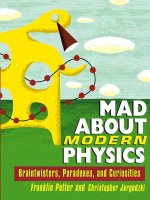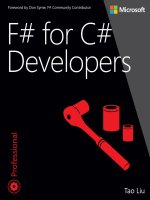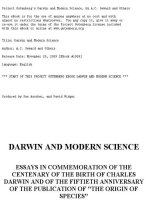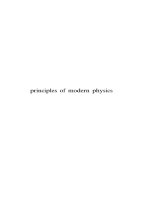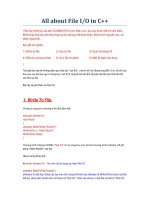- Trang chủ >>
- Khoa Học Tự Nhiên >>
- Vật lý
Mad about modern physics - f potter, c jargodzki
Bạn đang xem bản rút gọn của tài liệu. Xem và tải ngay bản đầy đủ của tài liệu tại đây (3.33 MB, 311 trang )
Mad about
Modern Physics
Mad about
Modern Physics
ffirs.qxd 10/13/04 3:27 PM Page i
ffirs.qxd 10/26/04 9:36 AM Page ii
Mad about
Modern Physics
Mad about
Modern Physics
Braintwisters, Paradoxes, and Curiosities
Franklin Potter
and
Christopher Jargodzki
John Wiley & Sons, Inc.
ffirs.qxd 10/13/04 3:27 PM Page iii
This book is printed on acid-free paper.
Copyright © 2005 by Franklin Potter and Christopher Jargodzki. All rights reserved
Illustrations on pages 2, 4, 9, 26, 31, 134, and 161 copyright © 2005 by Tina Cash-Walsh.
Published by John Wiley & Sons, Inc., Hoboken, New Jersey
Published simultaneously in Canada
Design and production by Navta Associates, Inc.
No part of this publication may be reproduced, stored in a retrieval system, or transmitted in any
form or by any means, electronic, mechanical, photocopying, recording, scanning, or otherwise,
except as permitted under Section 107 or 108 of the 1976 United States Copyright Act, without
either the prior written permission of the Publisher, or authorization through payment of the appro-
priate per-copy fee to the Copyright Clearance Center, 222 Rosewood Drive, Danvers, MA 01923,
(978) 750-8400, fax (978) 646-8600, or on the web at www.copyright.com. Requests to the Pub-
lisher for permission should be addressed to the Permissions Department, John Wiley & Sons, Inc.,
111 River Street, Hoboken, NJ 07030, (201) 748-6011, fax (201) 748-6008.
Limit of Liability/Disclaimer of Warranty: While the publisher and the author have used their best
efforts in preparing this book, they make no representations or warranties with respect to the accu-
racy or completeness of the contents of this book and specifically disclaim any implied warranties
of merchantability or fitness for a particular purpose. No warranty may be created or extended by
sales representatives or written sales materials. The advice and strategies contained herein may not
be suitable for your situation. You should consult with a professional where appropriate. Neither
the publisher nor the author shall be liable for any loss of profit or any other commercial damages,
including but not limited to special, incidental, consequential, or other damages.
For general information about our other products and services, please contact our Customer Care
Department within the United States at (800) 762-2974, outside the United States at (317) 572-
3993 or fax (317) 572-4002.
Wiley also publishes its books in a variety of electronic formats. Some content that appears in print
may not be available in electronic books. For more information about Wiley products, visit our web
Library of Congress Cataloging-in-Publication Data:
Potter, Frank, date
Mad about modern physics : braintwisters, paradoxes and curiosities / Franklin Potter and
Christopher Jargodzki.
p. cm.
Includes index.
ISBN 0-471-44855-9
1. Physics Popular works. I. Jargodzki, Christopher II. Title
QC24.5.P68 2004
530—dc22
2004014941
Printed in the United States of America
10 9 8 7 6 5 4 3 2 1
ffirs.qxd 10/13/04 3:27 PM Page iv
site at www.wiley.com.
To my late parents, who nourished my formative years and
have now crossed that portal to another world.
F. P.
To my late grandmother—Zofia Lesinska,
who instilled in me the idea that the visible world
owes its being to the invisible one.
C. J.
ffirs.qxd 10/13/04 3:27 PM Page v
ffirs.qxd 10/13/04 3:27 PM Page vi
vii
Contents
Preface . . . . . . . . . . . . . . . . . . . . . . . . . . ix
Acknowledgments. . . . . . . . . . . . . . . . . . xii
To the Reader . . . . . . . . . . . . . . . . . . . . . xiii
Chapter 1 The Heat Is On . . . . . . . . . . . . . . . . . . . . 1
Chapter 2 Does Anybody Really Know What
Time It Is?. . . . . . . . . . . . . . . . . . . . . . . . 11
Chapter 3 Crazy Circles . . . . . . . . . . . . . . . . . . . . . 19
Chapter 4 Fly Me to the Moon. . . . . . . . . . . . . . . . . 29
Chapter 5 Go Ask Alice. . . . . . . . . . . . . . . . . . . . . . 39
Chapter 6 Start Me Up . . . . . . . . . . . . . . . . . . . . . . 49
Chapter 7 A Whole New World. . . . . . . . . . . . . . . . . 63
Chapter 8 Chances Are . . . . . . . . . . . . . . . . . . . . . .
75
Chapter 9 Can This Be Real? . . . . . . . . . . . . . . . . .
91
Chapter 10 Over My Head. . . . . . . . . . . . . . . . . . . . . 105
Chapter
11
Crystal Blue Persuasion. . . . . . . . . . . . .
117
ftoc.qxd 10/13/04 3:29 PM Page vii
viii Contents
Answers
The Heat Is On . . . . . . . . . . . . . . . . . . . . . . 125
Does Anybody Really Know What
Time It Is? . . . . . . . . . . . . . . . . . . . . . . . 139
Crazy Circles . . . . . . . . . . . . . . . . . . . . . . .
151
Fly Me to the Moon . . . . . . . . . . . . . . . . . .
164
Go Ask Alice . . . . . . . . . . . . . . . . . . . . . . .
181
Start Me Up . . . . . . . . . . . . . . . . . . . . . . . .
192
A Whole New World . . . . . . . . . . . . . . . . . .
206
Chances Are. . . . . . . . . . . . . . . . . . . . . . . .
224
Can This Be Real? . . . . . . . . . . . . . . . . . . .
241
Over My Head . . . . . . . . . . . . . . . . . . . . . .
257
Crystal Blue Persuasion . . . . . . . . . . . . . .
277
Index . . . . . . . . . . . . . . . . . . . . . . . . . . 287
ftoc.qxd 10/13/04 3:29 PM Page viii
ix
Preface
T
his book of almost 250 puzzles begins where our first book, Mad
About Physics: Braintwisters, Paradoxes, and Curiosities (2001)
ended—with the physics of the late nineteenth and early twenti-
eth centuries. The Michelson-Morley experiment of 1887, the
challenges posed by atomic spectra and blackbody radiation, the
unexpected discoveries of X-rays in 1895, radioactivity in 1896, and
the electron in 1897 all loosened the protective belt of ad hoc hypothe-
ses around the mechanistic physics the nineteenth century had so
laboriously built. Anomalies and paradoxes abounded, ultimately
necessitating a radical rethinking of the very foundations of physics
and culminating in the theory of relativity and quantum mechanics.
Numerous applications of these new and strange concepts followed
very quickly as atomic and nuclear physics led to semiconductor
devices on the small scale and nuclear energy on the large scale. There-
fore we have developed a whole new set of challenges to tickle the
minds of our scientifically literate readers, from science students to
engineers to professionals in the sciences.
The challenges begin with the classical problem of getting a cooked
egg into a bottle through a narrow bottleneck and back out again and
progress gradually to the famous aging-twin paradox of the theory of
spec
ial relativity and eventually reach problems dealing with the large-
scale universe. In between, we explore the nature of time and of space
as well as how the world of films and television tends to sacrifice
physics for the sake of entertainment. We also consider some of the
more startling questions in relativity. For example, we ask whether a
person can go on a space journey out to a star 7,000 light-years distant
and return while aging only 40 years! And we certainly want to
emphasize the practical applications of microphysics through an exam-
ination of some properties of exotic fluids, unusual motors running on
air or on random motion, as well as thermal, electrical, and photonic
properties of mate
rials in a challenging journey into the atomic world.
flast.qxd 10/13/04 3:31 PM Page ix
x Preface
Particularly important microworld challenges include: What happened
to Schrödinger’s cat? Can a cup of coffee be the ultimate quantum
computer? Why is a Bose-Einstein condensate a new state of matter?
Why is quantum mechanical coherent scattering so important in devel-
oping new detectors for neutrinos and gravitational waves? When we
reach the nucleus, there are challenges about the accuracy of carbon-14
dating, the reason for neutron decay, and the amount of human
radioactivity. Then our journey reverses as we reach for the stars to con-
sider Olbers’ paradox about why the night sky is dark instead of burst-
ing with light, how gravitational lensing by galaxies works, and what
the total energy in the universe might be. This book finishes with a pot-
pourri of challenges from all categories that ranges from using bicycle
tracks in the mud to determine the direction of travel, to analyzing
water-spouting alligators, and ending with a space-crawling mechanical
invention that seems to defy the laws of physics.
The puzzles range in difficulty from simple questions (e.g., “Will
an old mechanical watch run faster or slower when taken to the
mountains?”) to subtle problems requiring more analysis (e.g., “Is the
Bragg scattering of X-rays from an ideal crystal a coherent scattering
process?”) Solutions and more than 300 references are provided, and
they constitute about two-thirds of the book.
As these examples demonstrate, most of the puzzles contain an ele-
ment of surprise. Indeed, one finds that commonsense conjecture and
proper physical reasoning often clash throughout this volume. Ein-
stein characterized common sense as the collection of prejudices
acquired by age eighteen, and we agree: at least in science, common
sense is to be refined and often transcended rather than venerated.
Many of the challenges were devised to undermine physical precon-
ceptions by employing paradoxes (from the Greek para and doxos,
meaning “beyond belief”) to create cognitive dissonance. Far from
being simply amusing, paradoxes are uniquely effective in addressing
specific deficiencies in understanding. Usually the contradiction
between gut instinct and physical reasoning for some people will be so
painful that they will go to great lengths to escape it even if it means
having to learn some physics in the process.
Philosopher Ludwig Wittgenstein considered paradoxes to be an
embodiment of disquietude, and as we have learned, these disqui-
etudes often foreshadow revolutionary developments in our thinking
flast.qxd 10/13/04 3:31 PM Page x
Preface xi
about the natural world. The counterintuitive upheavals resulting
from relativity theory and quantum mechanics in the twentieth cen-
tury only enhanced the reputation of the paradox as an agent for
change in our understanding of physical reality.
Such disquietudes, rather than unexplained experimental facts,
writes Gerald Holton in Thematic Origins of Scientific Thought, were
what led Einstein to rethink the foundations of physics in his three
papers of 1905. Each begins with the statement of formal asymmetries
of a predominantly aesthetic nature, then proposes a general postu-
late, not derivable directly from experience, that removes the asym-
metries. For example, in the paper on the quantum theory of light,
formal asymmetry existed between the discontinuous nature of parti-
cles and the continuous functions used to describe electromagnetic
radiation. As Holton notes, “The discussion of the photoelectric
effect, for which this paper is mostly remembered, occurs toward the
end, in a little over two pages out of the total sixteen.” Consistent
with this approach is Einstein’s statement in Physics and Reality
(1936), “We now realize . . . how much in error are those theorists
who believe that theory comes inductively from experience,” and later
in The Evolution of Physics (1938), coauthored with the Polish physi-
cist Leopold Infeld, “Physical concepts are free creations of the human
mind, and are not, however it may seem, uniquely determined by the
external world.”
As another sore point, the term “quantum mechanics” is really a
misnomer: quantum systems cannot be regarded as made up of sepa-
rate building blocks. In the helium atom, for instance, we do not have
electron A and electron B but simply a two-electron pattern in which
all separate identity is lost. This indivisible unity of the quantum world
is paralleled by another kind of unity—between subject and object. Is
light a wave or a particle? The answer seems to depend on the experi-
mental setup. In the double-slit experiment, the observations of light
yield characteristics of the box and its slits as much as of light itself.
Is reality then observer-dependent? And would this justify Einstein’s
insistence on the power of pure thought in the construction of physi-
cal reality? Modern physics seems particularly adept at generating such
disquietudes. If that’s the case, then perhaps the word Mad in the title
of our book should not be construed as a mere metaphor!
flast.qxd 10/13/04 3:31 PM Page xi
Acknowledgments
W
e all “stand on the shoulders of giants” as we develop our
minds to become individuals living today on our planet Earth.
And we owe so much to so many people that we cannot
acknowledge all of them.
Franklin Potter would like to express appreciation to his wife,
Patricia, and their two sons, David and Steven, for their love and
inspiration through many wonderful years of family adventures. He
also treasures the numerous inspiring physics discussions over the
decades with many friends and colleagues: Howard G. Preston,
Gregory Endo, Fletcher Goldin, David M. Scott, John Priest, Lowell
Wood, Julius S. Miller, George E. Miller, Leigh H. Palmer, Charles W.
Peck, Myron Bander, Joseph Weber, Richard Feynman, Willard Libby,
Edward Teller, and Kamal Das Gupta.
Christopher Jargodzki would like to express appreciation to
Myron Bander of the University of California at Irvine; Stephen Reu-
croft of Northeastern University in Boston; and James H. Taylor of
Central Missouri State University in Warrensburg. His interactions
with close to twenty thousand students (and counting!) in his classes
at UC Irvine, Northeastern University, and CMSU have been, over the
years, never-ending sources of stimulation, as well as occasional exas-
peration. In fact, the present volume got its start in 1975 when one of
us (C. J.), still a graduate student at UC Irvine, put together a proposal
for a book of paradoxes in modern physics, partly to allay his own
exasperation with the koanlike conundrums that abound in modern
physics. Alas, the project had to wait several decades for the author to
mature and join forces with Franklin Potter in our joint inquiry into
the nature of physical reality. The authors hope that physical reality is
duly impressed with their efforts.
Both authors sincerely thank Kate C. Bradford, senior editor at
John Wiley & Sons, Inc., who continues to support our paradoxical
adventures into the world of physics.
xii
flast.qxd 10/13/04 3:31 PM Page xii
xiii
To the Reader
T
hese puzzles are meant to be fun. How many puzzles you solve is
not as important as how many you enjoy thinking about. Some
of them are even challenging to research physicists, and some
were generated by research articles that have appeared only recently in
physics journals, so these topics may not have been part of physics just
10 years ago! It would be a rare reader who could provide detailed
solutions to all the puzzles. Indeed, sometimes you may need to think
a bit to even understand the answer. If we included all the steps, this
book would double its present size. We offer no apologies, but we do
try to provide all the key steps to make each answer complete on its
own. If you find the puzzles perplexing and intriguing, we have suc-
ceeded in our mission.
Mad about Modern Physics can be read with profit by anyone who
has had some exposure to a year of introductory physics and is eager
to learn more about its applications and its more recent discoveries.
Most puzzles are nonmathematical in character and require only a
qualitative application of fundamental physics principles. Many
physics concepts are defined directly or indirectly in the questions or
in the answers, so they can be found with the aid of the index. How-
ever, even someone who knows the subject will quickly realize that the
application of physics to the real world can be quite challenging, and
in this sense this is not an elementary book.
More than three hundred follow-up references provide further
resources for interested readers. These references—to journal research
papers, books, and magazine articles—are included with only some of
the puzzles, typically those that are either controversial or that involve
relatively new concepts. There was no space to include a more com-
plete list of references. Consequently we had to make choices, and we
apologize to the authors whose work may have been left out or inad-
vertently overlooked.
flast.qxd 10/13/04 3:31 PM Page xiii
Any errors are solely those of the authors, and we would appre-
ciate your communications via e-mail to Franklin Potter (see
www.sciencegems.com) with regard to the puzzles and their
answers.
xiv To the Reader
flast.qxd 10/13/04 3:31 PM Page xiv
The Heat
Is On
1
The Heat
Is On
S
CIENCE IN THE HOME CONTRIBUTES IMMENSELY
to our everyday repertoire of activities, although
most of us are unaware of exactly how science does so.
Physics, in particular, is all around us and plays a crucial role
in determining what we can and cannot do. One enjoyable
activity for many people is cooking, which is an application
of physics and chemistry to satisfy our gastronomical tastes.
Or are physics and chemistry just other modes of cooking?
We’ll let you decide. Most of the challenges in this chapter
involve physics from a high-school-level course. But be care-
ful. Quick responses may be correct occasionally, but you
should not rely on your intuition very much, for Nature,
particularly in the kitchen, is nonintuitive for the most part.
Anyone who has tried to make a soufflé can attest to how
limited a recipe can be!
1
c01.qxd 10/13/04 3:33 PM Page 1
1. Egg into a Bottle
Perhaps the most intriguing
physics-in-the-kitchen demon-
stration for all ages is get-
ting a hard-boiled egg with
the shell removed into a
bottle that has an opening
diameter smaller than the
minimum diameter of the
egg. One solution is to very
carefully drop some bits of
burning paper into
the upright bottle and
then place the egg at
the opening. Soon, if
the sequence is done
with the correct tim-
ing, the egg will have the urge to go inside. What is the
correct timing, and why does the egg have this urge?
2. Egg out of a Bottle
Perhaps the most challenging physics-in-the-kitchen
demonstration for all ages is getting a hard-boiled egg
with the shell removed out of a bottle that has an open-
ing diameter smaller than the minimum diameter of
the egg. Of course, one could cut up the egg with a
knife inserted into the bottle and then pour out the
pieces. However, we want the egg out whole and
undamaged.
Long ago, physics professor Julius Sumner Miller,
(who was Professor Wonderful on the early Mickey
Mouse Club shows) was on the Tonight Show with
host Johnny Carson and showed first how to get the
egg into the bottle and then, taking no more than three
2 Mad about Modern Physics
We can detect five
basic tastes—four are
very familiar: sweet,
sour, bitter, and salty.
The fifth, while familiar
in East Asia, is less well
known in Western
cuisine—it is called
and is the taste
of monosodium gluta-
mate, MSG. MSG is
used widely in Eastern
cooking and that is
probably why it is rec-
ognized as a separate
taste sensation more
readily by those familiar
with that cuisine. How-
ever, many common
western foods contain
large amounts of MSG,
notably tomatoes and
parmesan cheese.
—PETER BARHAM,
T
HE SCIENCE OF COOKING
I was raised in Alabama
and Florida a Southern
Baptist, a lad given
simple answers to pro-
found questions. At the
same time I came to
love science, which
seeks profound answers
to simple questions.
—EDWARD O. WILSON
Umami
Egg
Burning
paper
c01.qxd 10/13/04 3:33 PM Page 2
The Heat Is On 3
seconds, had the same egg back in his hand. What is the
procedure? (Hint: the same physics principles that put
the egg into the bottle can get the egg out.)
3. Sugar
Add two cups of sugar to one cup of water in a
saucepan and stir while heating slightly. All the sugar
will dissolve. About how much total sugar will dissolve
in one cup of water? What is the physics?
4. Kneading Bread
Bread made with yeast is usually kneaded—that is,
drawn out and pressed together to create a distribution
of the ingredients. Then the bread dough is set aside to
“rise.” Why is some bread then kneaded a second time
and sometimes even a third time before baking?
5. Measuring Out Butter
Suppose you have a solid chunk of butter and a meas-
uring cup in the kitchen. You desire to accurately
measure one-half cup of butter chunks without melting
them. What is a quick, easy way to do so? Often one
encounters the statement in cookbooks that Archi-
medes’ principle is being used. What is this principle,
and why is the statement erroneous?
6. Milk and Cream
You are given two identical bottles, one with milk and
the other with cream, both filled to the top. Quick now,
which is heavier? And is light cream lighter than heavy
cream?
Why is it that tea made
with microwave-heated
water doesn’t taste as
good as tea made with
teakettle water? The
main reason is that
microwaves heat only
the outer inch or so of
the water all around the
cup, because that’s as
far as they can pene-
trate. The water in the
middle of the cup gets
hot more slowly, through
contact with the outer
portions. When the
outer portions of the
water have reached boil-
ing temperature and
start to bubble, you can
be tricked into thinking
that all the water in the
cup is that hot. But the
average temperature
may be much lower, and
your tea will be short-
changed of good flavor.
—ROBERT L.WOLKE, WHAT
EINSTEIN TOLD HIS COOK:
K
ITCHEN SCIENCE EXPLAINED
If there were one drop
of water less in the
universe,
the whole world would
thirst.
—UGO BETTI,
I
TALIAN PLAYWRIGHT
c01.qxd 10/13/04 3:33 PM Page 3
7. Straw and Potato
A paper or plastic drinking straw can be pushed
through an uncooked potato. Explain the physics. If
you plan to try this demonstration, be sure that you
take appropriate safety precautions—keep your hands
and body out of harm’s way.
8. Blueberry Muffins
Marion loves to bake warm, fresh blueberry muffins,
with the blueberries almost uniformly distributed
throughout the muffin. She knows that if one simply
prepares the batter and mixes in the blueberries, they
may be uniformly distributed before entering the oven,
but upon baking they will gravitate to lodge in the
lower part of the muffin. How does she prevent this
natural downward drift?
9. Can of Soup
Some people buy canned soup and store the cans in the
cupboard. Some people even turn these soup cans
upside down for storage. If we open a can of soup that
was stored in the upright position by removing the top,
quite often all the concentrated ingredients are on the
bottom and must be scooped out with a spoon. Even
4 Mad about Modern Physics
CALORIC REQUIREMENT
BASED ON BODY WEIGHT
The basal calorie
requirement of the
average adult is ten
times the ideal weight
in pounds (e.g., 1,270
for 127 lbs.), plus 30
percent for light activity
(i.e., 1,650 kcal), 50
percent for moderate
activity (1,905 kcal),
and 100 percent for
heavy activity (2,540
kcal). Expressed slightly
differently, the basal
energy requirement is
about 1 kilocalorie per
hour for every kilogram
(2.2 lbs.) of ideal body
weight. Of course, any
estimate of calorie
requirements based on
such formulas is just
that—an .
Individual requirements
vary widely with age,
health, body size,
and environmental
temperature.
When men reach their
sixties and retire, they
go to pieces. Women go
right on cooking.
—GAIL SHEEHY,AMERICAN
JOURNALIST
estimate
Straw
Potato
Push down
c01.qxd 10/13/04 3:33 PM Page 4
The Heat Is On 5
then, not all the concentrate is removed. Suppose,
instead, we turn the same can upside down and open
the bottom. Upon turning the can over, the soup simply
rushes out into the pot. Why so?
10. Salt and Sugar
Salts have been used for thousands of years to preserve
meats, and sugar has been used to preserve fruits and
berries. How do they work?
11. Defrosting Tray
In catalogs and cookware stores one can buy a “mira-
cle” defrosting tray advertised as made of an
“advanced, space-age super-conductive alloy” that
“takes heat right out of the air.” How does this defrost-
ing tray work?
12. Ice Cream Delight
Most of us have made ice cream or seen ice cream being
made. Milk, eggs, sugar, and flavorings are slowly
chilled. Terri likes to make ice cream in a simpler and
more efficient way. Practicing proper safety precautions,
she pours liquid nitrogen directly into the ingredients in
a metal bowl. About equal volumes of liquid nitrogen
and the mixture are used for ice cream or sorbet, and
she stirs while adding the coolant until the ice cream is
nicely stiff. Why does this method produce absolutely
marvelous ice cream, and what is the physics here?
13. Cooking a Roast
For many types of meat—beef, pork, lamb, etc.—one
can buy a roast from the butcher with or without the
bone inside. Suppose we have two beef roasts of the same
The boiling temperature
of water decreases
about 1.9°F for every
1,000 feet above sea
level. So in Denver, the
mile-high city, water will
boil at 202°F—that is,
at 94.4°C. Tempera-
tures above 165°F are
generally thought to be
high enough to kill most
germs, so there is no
danger on this account
until you get to about
25,000 feet.
On the average we get
about 9 (food) calories
(kcal) of energy from
each gram of fat and
4 calories from each
gram of protein or
carbohydrate. To lose a
pound (454 g) of fat,
we have to cut the food
intake by 3,500 calo-
ries. The discrepancy in
numbers is due to the
fact that body fat is
only about 85 percent
actual fat, the rest
coming from connective
tissue, blood vessels,
and other things.
c01.qxd 10/13/04 3:33 PM Page 5
weight of 4.4 pounds (2 kg) and cook them in identical
ovens at the same temperature. One roast has the bone in
and the other does not. Which roast cooks faster? Why?
14. Cooking Chinese Style
Estimates of Chinese meals include more than 3,000
varieties, possibly more meal types than the total num-
ber of meals by all other cultures combined. Many of
the Chinese dishes use meats cut into small cubes or
other small volumes. Certainly, these small volumes are
much easier to eat with chopsticks. Are there any sig-
nificant scientific reasons for cutting up the meats into
small volumes?
15. Baked Beans
If you buy dry beans in bulk, they must be soaked in
water overnight in a covered container before they are
ready to be baked. To bake them without soaking
would require an enormous amount of cooking time.
An alternative preparation is to “parboil” them in a
cooking pot—that is, simmer them. Simmer means “to
be on the verge of boiling.”
How does one know that the beans have simmered
enough? The test involves good physics. Take up a few
beans in a spoon and, after making sure that no liquid
is in the spoon, blow a stream of air gently with pursed
lips against the beans. If the bean skin cracks, the beans
are ready for baking. Why must the lips be pursed, and
why do the bean skins then crack open?
16. Ice Water
Normally, to cool a pitcher of water quickly, one adds
ice. The ice floats at the top. Suppose one could add the
same amount of ice so it could be held in the water at
6 Mad about Modern Physics
Light bounces off mir-
rors; microwaves bounce
off metal. If what you
put in the microwave
oven reflects too many
microwaves back
instead of absorbing
them, the magnetron
tube that generates the
microwaves can be
damaged. There must
always be something in
the oven to absorb
microwaves. That’s why
you should never run it
empty.
Metals in microwave
ovens can behave
unpredictably. Micro-
waves set up electrical
currents in metals, and
if the metal object is too
thin it may not be able
to support the current
and will turn red hot and
melt. And if it has sharp
points, it may even act
like a lightning rod and
concentrate so much
microwave energy at the
points that it will send
off lightning-like
sparks.
—ROBERT L.WOLKE, WHAT
EINSTEIN TOLD HIS COOK:
K
ITCHEN SCIENCE EXPLAINED
c01.qxd 10/13/04 3:33 PM Page 6
The Heat Is On 7
the bottom of the pitcher. Which technique would lead
to faster cooling of the water?
17. Peeling Vegetables
A friend of ours peels ripe tomatoes by impaling the
tomato on a fork, then holding it over a gas flame and
rotating gently. If you try this procedure, use appropri-
ate safety procedures to protect your eyes and body.
Peeling fresh beets is also a messy chore. Their col-
ored liquid stains everything, including your fingers.
Another friend of ours peels fresh beets by first boiling
them, then immediately holding them under cold water
with a fork. What is the physics in both of these meth-
ods used for preparing vegetables for peeling?
18. Igniting a Sugar Cube
Sugar burns in air. But igniting
a sugar cube is much more dif-
ficult than expected. Put a
sugar cube on the end of a
toothpick and bring a lighted
match flame under a remote
corner. The sugar melts
instead of burning, and the
brown, gooey stuff is caramel.
However, we wish to burn
the sugar, not melt it! We want to see it on fire with a
flame of its own. Why is this process so difficult to
achieve? How can we succeed in lighting the sugar cube
with the burning match?
19. Water Boiling
An open pot of water is boiling on the kitchen stove.
Sprinkle some room-temperature table salt (which
A standard 12-ounce
aluminum can, whose
wall surfaces are
thinner than two pages
from this book (about
0.00762 cm), with-
stands more than 90
pounds of pressure per
square inch—three
times the pressure in an
automobile tire.
—WILLIAM HOSFORD AND
JOHN DUNCAN,“THE
ALUMINUM BEVERAGE CAN,”
S
CIENTIFIC AMERIC AN,
S
EPTEMBER 1994
Decaffeinated coffee
still contains caffeine!
A regular cup of
coffee has 80 to 135
milligrams of caffeine.
For a coffee to be con-
sidered decaffeinated,
at least 97 percent of
the coffee’s caffeine
must be removed. Test-
ing shows that decafs
typically have 2 to 6
milligrams of caffeine
per cup.
c01.qxd 10/13/04 3:33 PM Page 7
contains mostly NaCl and some KCl) into the clear
boiling water, and the boiling ceases. Isn’t it amazing
how the water ceases its boiling as the salt warms up!
Can you explain the physics? What is the surprise here?
20. Put the Kettle On
Bring water to a boil in a teakettle with a spout. Let it
cook! Now watch the mouth of the spout carefully.
What do you see? Can you see the water vapor come
out?
21. The Watched Pot
You have probably heard the expression “A watched
pot never boils.” Is this statement correct physics? That
is, when would this statement be good physics? (Hint:
One should interpret the phrase “never boils” here to
mean that the cooking takes a longer time.)
22. Ice in a Microwave
The microwave oven emits microwaves that are
absorbed by water molecules in food. Microwaves
make the polar water molecules rotate or oscillate, and
their “friction” within the material converts some of
this kinetic energy into thermal energy to raise the tem-
perature of the food.
Suppose you made an ice block that had liquid
water trapped in a large cavity inside and then you
placed the block into a microwave oven. Could the
trapped water be brought to a boil while the ice
remained ice?
8 Mad about Modern Physics
An object at room tem-
perature (20°C) emits
radiation with a peak at
the wavelength 9.89
micrometers, roughly
.01 mm, in the infrared
region of the electro-
magnetic spectrum.
For an isolated water
molecule the H-O-H
angle is 104.5°. In ice
each water molecule
forms hydrogen bonds
to four nearest neigh-
bors in a tetrahedral
arrangement. The tetra-
hedral bond geometry
explains the openness
and relatively low den-
sity of ice (i.e., why
water expands upon
freezing). In ice the
H-O-H angles are
nearly the same as the
perfect tetrahedral
angle of 109.5°.
c01.qxd 10/13/04 3:33 PM Page 8
The Heat Is On 9
23. The Glycemic Index
The glycemic index is an important number for anyone
concerned with the conversion of food to blood sugar
(sucrose), for the gylcemic index gives the measured
r
ate of this conversion process. The higher the glycemic
index value, the faster the conversion rate to sucrose.
There are types of sugar molecules other than sucrose.
Glucose, for example, is normally the standard reference
for the conversion rate to sucrose, with a value of 100.
Some sample values of the glycemic index for foods
are: brown rice, 59; white rice, 88; table sugar,
65; grapefruit, 25; spaghetti, 25 to 45; potato, boiled,
55; potato, baked, 85; and dates, 103. Brown rice has
more outer layer intact than white rice, so its lower
value is evident. But why would a baked potato have a
much higher glycemic index than a boiled potato? And
how could the value for dates, or any food, be higher
than 100?
24. Electric Pickle
Some specialty and novelty stores sell an electrical
“appliance” that cooks hot dogs between two metal
electrodes. A protective cover with a safety interlock
Night cooling by evapo-
ration of water and heat
radiation had been per-
fected by the peoples
of Egypt and India, and
several ancient cultures
had partially investi-
gated the ability of
salts to lower the freez-
ing temperature of
water. Both the ancient
Greeks and Romans
had figured out that
previously boiled water
will cool more rapidly
than unboiled water, but
they did not know why;
boiling rids the water
of carbon dioxide and
other gases that other-
wise retard the lowering
of water temperature.
—TOM SHACHTMAN
, A
BSOLUTE
ZERO AND THE CONQUEST
OF COLD
Interestingly, microwave
ovens are not very good
at melting ice. The
water molecules in ice
are bound pretty tightly
together into a crystal
lattice, so they can’t flip
back and forth under
the influence of micro-
waves’ oscillation.
c01.qxd 10/13/04 3:33 PM Page 9
closes over the device before electrical energy in the
form of a standard AC current can be applied. Suppose
that instead of a hot dog one places a pickle between the
electrodes. When the room lights are dimmed, the
pickle glows impressively, predominantly at one end.
What is the physics, and what might the glow look like?
25. Space-Age Cooking
Microwave ovens were probably the first new method
for making heat for cooking in more than a million
years. In addition, two newer methods have become
available for the kitchen. Magnetic induction cooktops
have been available for about fifteen years in Europe
and Japan and are now becoming known in the United
States. And for the modern chef, cooking with light in
a “light oven” has been done since the mid-1990s and
may become a fad in the immediate future. How do
both of these cooking sources work?
10 Mad about Modern Physics
Although it flies in the
face of common sense,
people with more insula-
tion—fat—whose body
core is better protected
from the cold, may feel
cold more quickly than
thinner people with less
protection. The reason
is that insulation keeps
heat in the core, away
from the skin, which
gets cold. When the
skin gets cold, you feel
cold. Paradoxically,
women may feel colder
than men because
women are better
insulated.
—JAMES GORMAN
,“BEYOND
BRR:THE ELUSIVE SCIENCE
OF COLD,” THE NEW YORK
TIMES, FEBRUARY
10, 2004
The main compartment
of a refrigerator should
always be below 40°F
(4.4°C). Above that
temperature, bacteria
can multiply fast
enough to be dangerous.
c01.qxd 10/13/04 3:33 PM Page 10

